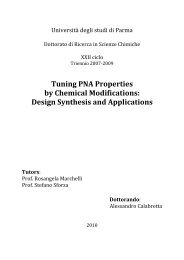Create successful ePaper yourself
Turn your PDF publications into a flip-book with our unique Google optimized e-Paper software.
Int Arch Occup Environ Health (2008) 81:487–493<br />
DOI 10.1007/s00420-007-0242-8<br />
ORGINAL ARTICLE<br />
Chromium in exhaled breath condensate and pulmonary tissue<br />
of non-small cell lung cancer patients<br />
Matteo Goldoni · Andrea Caglieri · Massimo Corradi ·<br />
Diana Poli · Michele Rusca · Paolo Carbognani ·<br />
Antonio Mutti<br />
Received: 24 November 2006 / Accepted: 14 August 2007 / Published online: 28 August 2007<br />
© Springer-Verlag 2007<br />
Abstract<br />
Objective Chromium in exhaled breath condensate (EBC)<br />
has recently been proposed as a biomarker of pulmonary<br />
exposure. The aim of this study was to measure the Cr levels<br />
in the EBC and pulmonary tissue of patients with early,<br />
operable non-small cell lung cancer (NSCLC) who had not<br />
been occupationally exposed to Cr before and after tumour<br />
resection and to correlate Cr in lung tissue with that in<br />
EBC.<br />
Methods Cr levels in the EBC and pulmonary tissue of 20<br />
NSCLC patients were measured by means of electrothermal<br />
atomic absorption before and after tumour resection. Cr<br />
levels were also measured in the urine of 15 of these<br />
patients.<br />
Results The pre-surgery EBC Cr levels of the NSCLC<br />
patients were not diVerent from those of the controls, but<br />
both EBC and urinary Cr levels increased after surgery.<br />
There was a signiWcant correlation between Cr levels in<br />
EBC and pulmonary tissue (R = 0.55, P = 0.01), but not<br />
between these and urinary Cr levels.<br />
M. Goldoni · A. Caglieri · M. Corradi · D. Poli · A. Mutti (&)<br />
Laboratory of Industrial Toxicology,<br />
Department of Clinical Medicine,<br />
Nephrology and Health Sciences,<br />
University of Parma, Via Gramsci 14,<br />
43100 Parma, Italy<br />
e-mail: antonio.mutti@unipr.it<br />
M. Goldoni · A. Caglieri · D. Poli<br />
National Institute of Occupational Safety and Prevention<br />
Research Center at the University of Parma,<br />
Via Gramsci 14, 43100 Parma, Italy<br />
M. Rusca · P. Carbognani<br />
Unit of Thoracic Surgery, University of Parma,<br />
Via Gramsci 14, 43100 Parma, Italy<br />
Conclusion Cr levels in EBC and urine of NSCLC<br />
patients were increased after surgical intervention. Measured<br />
Cr EBC levels were by one order of magnitude lower<br />
than those observed in moderately exposed workers. This<br />
fact, together with the correlation between Cr in EBC and<br />
in pulmonary tissue, conWrms that EBC is a promising biological<br />
Xuid to test pulmonary exposure to Cr, giving complementary<br />
information to that provided by urinary Cr, not<br />
correlated with EBC and tissue.<br />
Keywords Chromium · Exhaled breath condensate ·<br />
Lung cancer · Pulmonary tissue<br />
Introduction<br />
Chromium in the trivalent oxidation state [Cr(III)] shows<br />
limited toxicological properties, whereas hexavalent chromium<br />
[Cr(VI)] compounds have been classiWed as class 1<br />
carcinogens by the IARC (IARC 1990). Indeed, there is<br />
suYcient epidemiological and experimental evidence indicating<br />
that exposure to Cr(VI) is associated with an<br />
increased incidence of lung cancer (De Flora et al. 1990;<br />
ATSDR 2000; De Flora 2000; Gibb et al. 2000; Park et al.<br />
2004). Cr(VI) compounds have a number of industrial<br />
applications and exposure usually occurs by inhalation. The<br />
respiratory tract is therefore the primary target organ of<br />
Cr(VI) toxicity and carcinogenicity (ATSDR 2000; De<br />
Flora 2000).<br />
Owing to the pneumotoxic properties of Cr(VI), some<br />
authors have directly measured Cr concentrations in the<br />
pulmonary tissue of chromate workers and also lung cancer<br />
patients, because urine and blood Cr levels are more representative<br />
of systemic than target organ exposure. In general,<br />
chromate workers with or without lung cancer have<br />
123
















